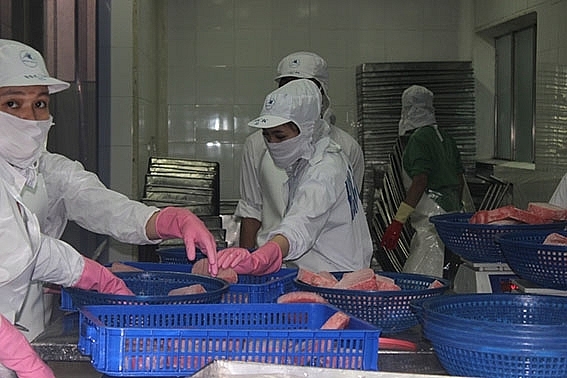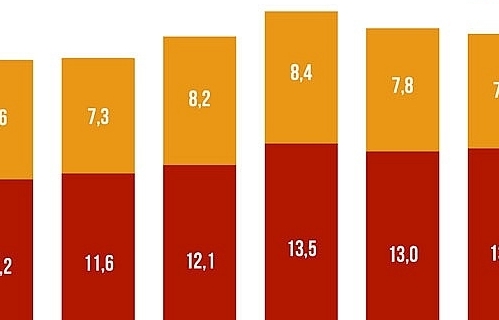Seafood export expectations from market structure and deep processing
| Seafood exports declined sharply in the first month of the year | |
| Seafood exports surge | |
| Seafood exports achieve remarkable turnover |
 |
| Deep processing will help increase the value of exported seafood. Photo: T.H |
Increasing deep processing
In 2022, Vietnam's seafood industry had a remarkable year of recovery and growth, despite many fluctuations in the second half of the year.
Vietnam's seafood export had reached the target of US$ 1 billion, up 25% compared to 2021. This is the record level of Vietnam's seafood industry in more than 20 years of exporting to the world market. However, in the face of market fluctuations, the strategy of the seafood industry in 2023 will gradually shift from exploitation and fishing to farming and deep processing to maintain sustainable growth. In 2023, the seafood industry sets a target of export turnover of about US$ 10 billion, with a total output of about 8.74 million tons, equaling 96.7% of the estimated implementation in 2022. Exploiting about 3.58 million tons, and farming 5.16 million tons.
In the context of difficulties lasting from the last months of 2022, Vietnamese exporters also face challenges such as currency fluctuations, especially debts payable in USD and competitive pressure from rival suppliers - especially shrimp exporters. With substitute products at more reasonable prices, consumers will reduce spending in the face of inflationary pressure, and pangasius exports maintain a better growth momentum than shrimp exports.
In a recent report, the Center for Analysis and Investment Consulting of SSI Securities Joint Stock Company said that in 2023, inflation would continue to be a challenge for the seafood industry in the context of slow-rotating inventories.
Although major seasonal events are coming, these events will not reduce inventories that are already high. SSI forecast the inventory would be fully cleared in the third quarter of 2023, with orders beginning to be received at this point.
In order to export seafood to reduce dependence on frozen products, the Ministry of Agriculture and Rural Development required that enterprises should increase the deep processing of seafood associated with export, which would be a strategic solution. Deputy Minister of Agriculture and Rural Development Phung Duc Tien said that with the current difficulties and challenges in some export markets, the seafood industry should focus on solutions, in which, strengthening deep processing; the source of raw materials must be traceable; promoting trade flexibly with markets through 17 new generation FTAs.
Mr. Ho Quoc Luc, Chairman of the Board of Directors of Sao Ta Food Joint Stock Company, said that thanks to the changing market structure, along with the increase in deep processing, the company had achieved high export revenue. In 2022, Sao Ta Food Joint Stock Company's sales reached nearly US$ 230 million, an increase of nearly 10% and profit was likely to reach over VND 340 billion. Along with that, the company's export market structure had changed quite strongly.
Accordingly, the market share in Japan increased significantly, from 28.1% (in 2020), to 38.9% (2021) and 43.8% in 2022. The deeply processed product was mainly for the Japanese had accounted for about 55% of the general product. Mr. Ho Quoc Luc said that, with certain difficulties caused by the impact of the economy, in 2023, when major markets were very quiet, especially the blizzard at the end of 2022 in the United States, it would reduce spending power, causing inventory not to be released in time. Sao Ta still had orders for daily processing.
Expectations of the Chinese market
China's reopening is a catalyst for the industry in 2023. Although more time is needed to assess the quantitative impact of China's reopening on pangasius exports, this will make beneficial to the industry's revenue because China is Vietnam's largest pangasius export market. According to Mr. Truong Dinh Hoe, General Secretary of VASEP, Vietnamese seafood had gained market share in provinces with large consumption such as Shandong, Shanghai, Liaoning, Fujian, Beijing and Tianjin. These localities accounted for 87% of China's total seafood import turnover. In Shandong province alone, this province imported US$ 4 billion of seafood a year. According to Mr. Hoe, in order to increase exports to China, it was necessary to have specific measures to market to the Chinese market more effectively than now. In which, setting up a direct selling agency for Vietnamese people. However, it was necessary to consider which location was suitable.
From a business perspective, Mr. Ho Quoc Luc, Chairman of the Board of Directors of Sao Food Joint Stock Company, said that it was very difficult to penetrate the Chinese market for shrimp, especially white leg shrimp. China had more than 1,000 shrimp processing enterprises. Each year, they imported millions of tons of raw shrimp for processing, mainly from Ecuador, India and Argentina for processing to serve the country. Therefore, only pangasius and black tiger shrimp could penetrate.
According to Mr. Ho Quoc Luc, the immediate strategy for the shrimp industry was to focus on the market that favored shrimp products with high value-added content, which Ecuador and India had not been able to penetrate like Japan, and West Europe.
China is a sensitive market for price and the average selling price to this market is always about 40% lower than the average selling price to the US market. SSI Research believed that revenue from the Chinese market would partially offset the decline in revenue from the US and EU, but not enough to provide a chance for companies to recover profits in the first half of 2023.
SSI experts commented: “We remain concerned about the level of uncertainty surrounding China's reopening policies. However, for now, we forecast pangasius companies' profits to decline in 2023.”
Related News

Promoting agricultural exports to the Japanese market
13:55 | 22/12/2024 Import-Export
Latest News

UK a niche market for Vietnamese speciality coffee
14:11 | 23/12/2024 Import-Export

Vietnam-US trade thrives on effective mechanisms: trade counsellor
14:08 | 23/12/2024 Import-Export

Opening of overseas markets boosts coconut exports
13:59 | 23/12/2024 Import-Export

Increasing consumption demand, steel enterprises face many opportunities
11:08 | 23/12/2024 Import-Export
More News

VN faced with increasing trade defence investigations on rising protectionism
18:58 | 22/12/2024 Import-Export

Việt Nam expects to officially export passion fruit to the US next year
18:55 | 22/12/2024 Import-Export

UK’s carbon tax to affect VN exports
18:51 | 22/12/2024 Import-Export

Removing obstacles in granting certificates of exploited aquatic products
13:56 | 22/12/2024 Import-Export

Agricultural exports in 2024 to exceed 60 billion USD?
13:53 | 22/12/2024 Import-Export

Seafood exports expected to exceed $10 billion in 2025: expert
20:28 | 21/12/2024 Import-Export

Top 10 Reputable Animal Feed Companies in 2024: Efforts to survive the challenges of nature
18:30 | 21/12/2024 Import-Export

Vietnam's import-export surges 15.3%
09:44 | 20/12/2024 Import-Export

More Vietnamese firms interested in Saudi Arabia: Ambassador
09:43 | 20/12/2024 Import-Export
Your care

UK a niche market for Vietnamese speciality coffee
14:11 | 23/12/2024 Import-Export

Vietnam-US trade thrives on effective mechanisms: trade counsellor
14:08 | 23/12/2024 Import-Export

Opening of overseas markets boosts coconut exports
13:59 | 23/12/2024 Import-Export

Increasing consumption demand, steel enterprises face many opportunities
11:08 | 23/12/2024 Import-Export

VN faced with increasing trade defence investigations on rising protectionism
18:58 | 22/12/2024 Import-Export




